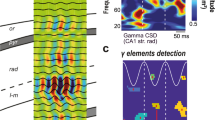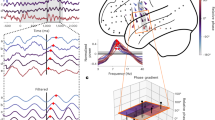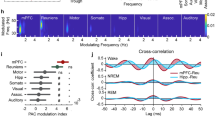Abstract
Different regions of the brain must communicate with each other to provide the basis for the integration of sensory information, sensory-motor coordination and many other functions that are critical for learning, memory, information processing, perception and the behaviour of organisms. Hebb1 suggested that this is accomplished by the formation of assemblies of cells whose synaptic linkages are strengthened whenever the cells are activated or ‘ignited’ synchronously. Hebb's seminal concept has intrigued investigators since its formulation, but the technology to demonstrate its existence had been lacking until the past decade. Previous studies have shown that very fast electroencephalographic activity in the gamma band (20–70 Hz) increases during, and may be involved in, the formation of percepts and memory2,3,4,5,6, linguistic processing7, and other behavioural and preceptual functions8,9,10,11,12. We show here that increased gamma-band activity is also involved in associative learning. In addition, we find that another measure, gamma-band coherence, increases between regions of the brain that receive the two classes of stimuli involved in an associative-learning procedure in humans. An increase in coherence could fulfil the criteria required for the formation of hebbian cell assemblies1, binding together parts of the brain that must communicate with one another in order for associative learning to take place. In this way, coherence may be a signature for this and other types of learning.
This is a preview of subscription content, access via your institution
Access options
Subscribe to this journal
Receive 51 print issues and online access
$199.00 per year
only $3.90 per issue
Buy this article
- Purchase on Springer Link
- Instant access to full article PDF
Prices may be subject to local taxes which are calculated during checkout


Similar content being viewed by others
References
Hebb, D. O. The Organization of Behavior (Wiley, New York, (1949)).
Singer, W. & Gray, C. M. Visual feature integration and the temporal correlation hypothesis. Annu. Rev. Neurosci. 18, 555–586 (1995).
Basar, E., Basar-Eroglu, C. & Schürmann, M. Sensory and cognitive components of brain resonance responses. Acta Otolaryngol (Stockh.) 491, 25–35 (1991).
Engel, A. K., Konig, P., Kreiter, A. K. & Singer, W. Interhemispheric synchronization of oscillatory neuronal responses in cat visual cortex. Science 252, 1177–1179 (1991).
Pantev, C. Evoked and induced gamma-band activity of the human cortex. Brain Topogr. 7, 321–330 (1995).
Singer, W. The formation of cooperative cell assemblies in the visual cortex. J. Exp. Biol. 153, 177–197 (1990).
Pulvermüller, F., Lutzenberger, W., Preißl, H. & Birbaumer, N. Spectral responses in the gamma-band: physiological signs of higher cognitive processes? Neuroreport 6, 2059–2064 (1995).
Murthy, V. N., Aoki, F. & Fetz, E. E. in Oscillatory Event-Related Brain Dynamics (eds Pantev, C., Elbert,T. & Lütkenhöner, B.) 213–226 (Plenum, New York, (1994)).
Llinas, R. R. & Ribary, U. Coherent 40-Hz oscillation characterizes dream state in humans. Proc. Natl Acad. Sci. USA 90, 2078–2081 (1993).
Sheer, D. E. in Self-regulation of the Brain and Behavior (eds Elbert, T., Rockstroh, B., Lutzenberg, W. & Birbaumer, N.) 64–84 (Springer, Berlin, (1984)).
Steriade, M., Amzica, F. & Contreras, D. Synchronization of fast (30–40 Hz) spontaneous cortical rhythms during brain activation. J. Neurosci. 16, 392–417 (1996).
Tiitinen, H. et al. Selective attention enhances the auditory 40-Hz transient response in humans. Nature 364, 59–60 (1993).
Oldfield, R. C. The assessment and analysis of handedness: the Edinburgh inventory. Neuropsychology 9, 97–113 (1971).
Pulvermüller, F., Birbaumer, N., Lutzenberger, W. & Mohr, B. High-frequency brain activity: its possible role in attention, perception and language processing. Prog. Neurobiol. 52, 427–445 (1997).
Arnold, M., Miltner, W. H. R., Bauer, R. & Braun, C. Adaptive AR modeling of nonstationary time series by means of Kalnan filtering. IEEE Trans. Biomed. Eng. 45, 553–562 (1998).
Rockstroh, B., Elbert, T., Canavan, A., Lutzenberger, W. & Birbaumer, N. Slow Cortical Potentials and Behaviour (Urban & Schwarzenberg, Munich, (1989)).
Waschulewski Floruss, H., Miltner, W., Brody, S. & Braun, C. Classical conditioning of pain responses. Int. J. Neurosci. 78, 21–32 (1994).
Gray, C. M. & McCormick, D. A. Chattering cells: superficial pyramidal neurons contributing to the generation of synchronous oscillations in the visual cortex. Science 274, 109–113 (1996).
Gray, C. M., Konig, P., Engel, A. K. & Singer, W. Oscillatory responses in cat visual cortex exhibit inter-columnar synchronization which reflects global stimulus properties. Nature 338, 334–337 (1989).
Jefferys, J. G., Traub, R. D. & Whittington, M. A. Neuronal networks for induced ‘40 Hz’ rhythms. Trends Neurosci. 19, 202–208 (1996).
Traub, R. D., Whittington, M. A., Stanford, I. M. & Jefferys, J. G. Amechanism for generation of long-range synchronous fast oscillations in the cortex. Nature 383, 621–624 (1996).
Bromm, B. & Meier, W. The intracutaneous stimulus: a new pain model for algesimetric studies. Meth. Find. Exp. Clin. Pharmacol. 6, 405–410 (1984).
Gratton, G., Coles, M. G. & Donchin, E. Anew method for off-line removal of ocular artifact. Electroencephalogr. Clin. Neurophysiol. 55, 468–484 (1983).
Perrin, F., Pernier, J., Bertrand, O. & Echallier, J. F. Spherical splines for scalp potential and current density mapping. Electroencephalogr. Clin. Neurophysiol. 72, 184–187 (1989).
Biggins, C. A., Fein, G., Raz, J. & Amir, A. Artifactually high coherences result from using spherical spline computation of scalp current density. Electroencephalogr. Clin. Neurophysiol. 79, 413–419 (1991).
Perrin, F. Comments on article by Biggins et al. Electroencephalogr. Clin. Neurophysiol. 83, 171–174 (1992).
Haykin, S. Adaptive Filter Theory (Prentice-Hall, Englewood Cliffs, New Jersey, (1986)).
Chen, H. H. & Guo, L. Identification and Stochastic Adaptive Control (Birkhäuser, Boston, Massachusetts, (1991)).
Acknowledgements
We thank I. Gutberlet for assistance in data analysis. This research was supported by a grant from the Deutsche Forschungsgemeinschaft to W.H.R.M. and a grant from the Rehabilitation Research and Development service, US Department of Veterans Affairs to E.T.
Author information
Authors and Affiliations
Rights and permissions
About this article
Cite this article
Miltner, W., Braun, C., Arnold, M. et al. Coherence of gamma-band EEG activity as a basis for associative learning. Nature 397, 434–436 (1999). https://doi.org/10.1038/17126
Received:
Accepted:
Issue Date:
DOI: https://doi.org/10.1038/17126
This article is cited by
-
Increased EEG gamma power under exposure to drug-related cues: a translational index for cue-elicited craving in METH-dependent individuals
BMC Psychiatry (2023)
-
Nested-spectral analysis reveals a disruption of behavioral-related dynamic functional balance in the aging brain
Nonlinear Dynamics (2023)
-
Disarrangement and reorganization of the hippocampal functional connectivity during the spatial path adjustment of pigeons
BMC Zoology (2022)
-
Ensemble of coupling forms and networks among brain rhythms as function of states and cognition
Communications Biology (2022)
-
A randomized pharmacological fMRI trial investigating d-cycloserine and brain plasticity mechanisms in learned pain responses
Scientific Reports (2022)
Comments
By submitting a comment you agree to abide by our Terms and Community Guidelines. If you find something abusive or that does not comply with our terms or guidelines please flag it as inappropriate.



